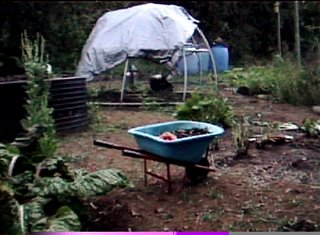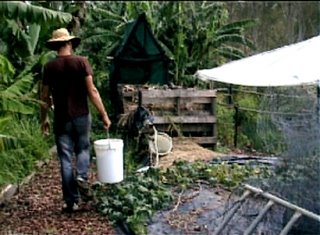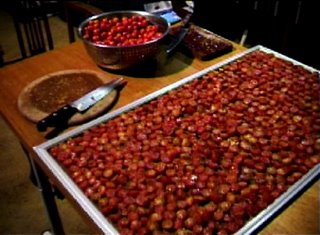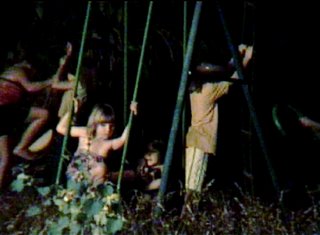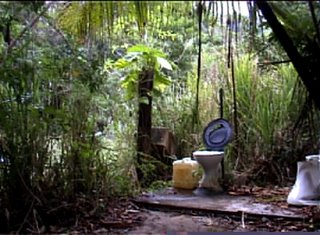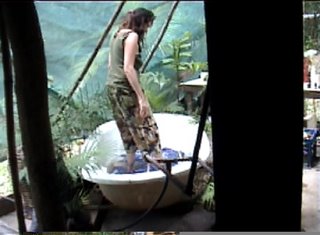Crystal Waters
Crystal Waters
This community is so huge it gives the impression of a living organism. The 85 plots house hundreds of residents, each with their own focus and approach to sustainability. The wealth of knowledge here has caused the place to become almost a display village. Many residents assist this process by running courses and workshops in the community spaces for the public and students of lifestyle. There are also many efforts to link Crystal Waters to national and global Eco-Village networks. There is a community newsletter and many residents publish books and contribute articles to Magazines such as Genoa, Eco-living, Diggers and Dreamers and Earth Garden.
Other residents focus on personal businesses or just getting on with living sustainably, they aren’t so actively in ‘spreading the word’. This leads to an interesting atmosphere within the community. As Australia turns it’s head toward sustainability it shines the spotlight on places like Crystal Waters. I got the feeling some residents have a vision of city people running for the hills in search of help when crunch time comes, will they be ready to help? I am so excited by the dynamic atmosphere that is created as mainstream Australia grapples with ecologically friendly living as a growingly urgent priority. Residents of sustainable communities all over Australia have built their knowledge through years of trial and error and the perseverance it takes to break away from the mainstream, now the mainstream wants to join in. In the city ideas like ‘sustainable living’, ‘organics’ and 'renewable energy’ are all entering the conciousnes of city dwellers. These options are being introduced through largely corporate means as big business responds to public demand. I am presented with two different worlds, green living entering the mainstream and green living in communities built on a passion for community connection. Can we bring eco-friendly technology into our highly individualised lives? What to you think? I reckon we will find out soon, get involved and help the process evolve so I can find out sooner! It is an exciting time to be alive! It seems to me that fixing the earth is the first step to fixing our own health and well-being, I take all increased care as a good sign. Maybe I can tout that idea to A Current Affair: The “Attain Spiritual Wellbeing By Saving The Earth” no, actually, the “Loose Weight by Saving The Earth Diet” YEAH! Send any ideas (perhaps a reality TV show?) to me at emptycageproductions@yahoo.com.au
Back at Crystal Waters…
Despite all the variations in focus, individual differences aren’t as devastating here as they are in smaller communities. At Crystal Waters you can chose with whom and how much you are involved. This does lead to a bit of an involvement hierarchy: the more you are involved more effect you have in the community goings on, but this system seems to be self-regulating. It also economises on people’s initial energy and enthusiasm and lets people rest when they are burnt out.
When Crystal Waters’ committees vote on issues they require a two thirds majority. I really like this system, it cuts the hours of discussion time to arrive at unanimity but often requires some consensus building which leaves fewer ‘losers’ than a 50/50 vote. Most times the members here all agree anyway.
Here is one of Crystal Waters’ 85 different interpretations of a permaculture garden. There is also a communal garden, dairy and bakery which supplies the general store. The organic produce grown here is also sold at market days that locals, visitors, Wwoofers and residents attend.
A landscaped water recycling system in the making.
At Crystal Waters I met and Wwoofed with the lovely Christopher Bradley, an ex-restaurateur from Sydney. Christopher sold up shop and moved here about three years ago.
This is his circular permaculture garden where we collected our lunch every day. I miss those salads…and Christopher!
Many residents build a temporary house during the making of their final house. This is the case with Christopher’s beautiful future studio where he now lives. His temporary loo is one of the simplest to make, It creates effective safe soil in 12 months. (there is a lurking bucket under this seat)
Here is the lovely Guillaume saving the day… I know you’re all cringing but trust me, emptying the poo bucket is very satisfying! Turning something you didn’t want anything to do with in to something useful is a great feeling. Once you’ve had poo bucket, you never go back baby yeah!
That reminds me, to meet someone equally enthusiastic about poo meet Hamish http://www.naturalevent.com.au/ who runs the best festival in Australia. Go to FRL,http://www.bilyana.com/ I’ll change your life.
We sun-dried the extra crop of cherry tomatoes. Solar power go!
Muhahaha I’m from South Australia so cane toads are hilariously novel to me, these pests are still prolific in Queensland and not so funny to the locals.
Due to minimal car movement (there is a 30K speed limit) no cats and dogs and protective neighbours, native wildlife also thrives at Crystal Waters. Kangaroos are everywhere and residents must get creative keeping them out of the garden beds. Heavy-duty fences are a common solution.
There is so much more to tell here… Check out their website for info on Crystal Waters’ history, infrastructure and courses coming up. I recommend a visit here if you have any interest in permaculture or ecologically-friendly housing. The architecture here will blow you away, very creative, unique and stylish. Check out the website. http://genoa.ecovillage.org/genoceania/ecocentre/index.html
Then my circus family all played on the beach and I skipped merrily on my way!
